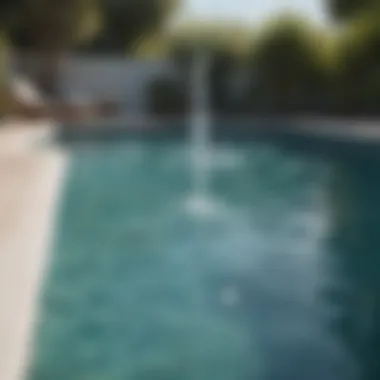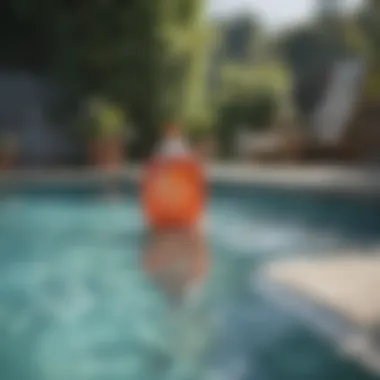Understanding the Best Pool Shock Treatments


Intro
Maintaining a swimming pool requires knowledge, especially in chemical treatment. One key aspect is pool shock, essential for ensuring water is safe and clear. Pool shock refers to the process of super-chlorinating water to eliminate contaminants, including bacteria and algae. For homeowners, understanding the different types of pool shock treatments available is vital. This knowledge helps in making informed decisions, impacting water quality and overall pool health.
The effectiveness of pool shock treatments largely depends on their chemical compositions. Various options exist in the market, each with unique advantages and ideal usage scenarios. It's key to understand these differences to select the right treatment for your pool.
This article explores the various types of pool shock, their effectiveness, and considerations like environmental impact and dosing techniques. The conclusion will synthesize the information, guiding homeowners toward the best practices for maintaining their pools.
Preamble to Pool Shock
Understanding the role of pool shock is crucial for any pool owner who desires clear and safe water. Pool shock is not merely a chemical, but a fundamental aspect of maintaining a pool’s hygiene and appearance. This section serves to introduce the concept of pool shock, its varied types, and the importance of incorporating it into regular pool maintenance routines. By examining the significance of pool shock, homeowners can make informed decisions, ensuring their pools remain welcoming and healthy.
What is Pool Shock?
Pool shock refers to the process of rapidly increasing the chlorine levels in pool water to eliminate contaminants and clear cloudy water. It essentially acts as an intense treatment designed to kill bacteria, algae, and other undesirable organisms. Various forms of pool shock exist, each with different chemical compositions and purposes. The most common substances include calcium hypochlorite, sodium dichloroisocyanurate, potassium monopersulfate, and liquid chlorine. Each of these types provides distinct advantages and considerations, depending on the specific needs of the pool.
Importance of Using Pool Shock
Utilizing pool shock is essential for several reasons:
- Sanitation: Regular application helps to maintain a high level of cleanliness in pool water, ensuring it is free from harmful pathogens.
- Water Clarity: Shocking combats cloudiness and enhances overall visibility, making the swimming experience more enjoyable.
- Algae Control: It effectively prevents and treats algae growth, which can lead to slippery surfaces and unfavorable conditions.
- Balanced Chemistry: Pool shock helps to maintain balanced water chemistry. This balance is crucial to avoid irritation of the skin and eyes for swimmers.
"Regularly shocking your pool can dramatically reduce the amount of harmful bacteria and enhance the swimming experience for homeowners and guests."
In summary, the importance of understanding pool shock can not be overstated. It is ultimately a key factor in achieving a pristine, safe swimming environment. The subsequent sections will delve deeper into the types of pool shock, their effectiveness, application techniques, and common mistakes to avoid.
Types of Pool Shock
Understanding the different types of pool shock is crucial for homeowners who want to maintain clear and safe swimming water. Each type comes with unique properties, benefits, and optimal usage scenarios, making it important to choose the right one for your pool. By grasping the distinctions among these types, you can effectively combat common water quality issues, such as algae growth and bacteria. Moreover, selecting the right pool shock minimizes potential problems like skin irritation or damage to your pool's materials. This section will explore the key types of pool shock, emphasizing their chemical compositions and practical applications for maintaining a healthy swimming environment.
Calcium Hypochlorite
Calcium Hypochlorite is one of the most widely used pool shock treatments. It is a solid form of chlorine that dissolves easily in water. This type of shock is known for its high chlorine content, which effectively increases the free chlorine levels in your pool. This rapid action is particularly beneficial after heavy use or following rainstorms that might introduce contaminants.
The use of Calcium Hypochlorite also helps sanitize the pool, eliminating harmful bacteria and algae. Homeowners appreciate its convenience, as it typically comes in granular form and can be added directly to the water. However, care should be taken to follow dosing guidelines closely to avoid overdosing, which could lead to irritation or damage.
Sodium Dichloroisocyanurate
Sodium Dichloroisocyanurate, often referred to as "Dichlor," is another popular pool shock option. This compound is a chlorine stabilizer, meaning that it is less prone to degradation from sunlight compared to Calcium Hypochlorite. This characteristic is particularly advantageous for outdoor pools, where excessive sunlight can reduce chlorine effectiveness.
Dichlor is available in both granules and tablets, making it versatile for different application methods. It is effective at raising chlorine levels quickly while also providing stability in long-term use. Moreover, the stabilizing properties help maintain water clarity by preventing fluctuations in chlorine levels.


Potassium Monopersulfate
Potassium Monopersulfate is a non-chlorine shock alternative, which makes it an excellent option for homeowners looking for a milder option. This type of shock is effective at breaking down organic matter, including oils and contaminants, without raising chlorine levels significantly.
Because it does not contain chlorine, Potassium Monopersulfate is often used during swim times, allowing people to enter the pool soon after application. This feature makes it appealing for social events when pool usage is high. However, while it is effective at clarifying water, it should not be seen as a substitute for regular chlorination in the long term.
Liquid Chlorine
Liquid Chlorine, also known as sodium hypochlorite, is a highly efficient option for shocking pools. Unlike other forms of shock, it is delivered in a liquid state, making it easy to add directly to the water without waiting for dissolution. Homeowners benefit from its immediate ability to elevate chlorine levels, which makes it an ideal choice for quick interventions after heavy rains or pool parties.
However, Liquid Chlorine can be more volatile and must be handled carefully. It has a shorter shelf life compared to solid forms of shock, which means it is pertinent to store it properly to maintain efficacy. Additionally, homeowners should take care not to mix it with other chemicals before application, as this can lead to dangerous reactions.
Evaluating Effectiveness
Understanding the effectiveness of pool shock is crucial for maintaining a clear and safe swimming environment. The right choice of pool shock not only ensures hygiene but also protects the investment you have made in your pool. Evaluating effectiveness means looking at how well a particular type of pool shock meets the needs of your specific situation. This section will discuss Immediate Chlorine Demand, Long-term Stability, and Environmental Considerations, each of which plays a significant role in determining the best type of pool shock for your needs.
Immediate Chlorine Demand
Immediate chlorine demand refers to the amount of chlorine that is required to effectively sanitize water at the moment of application. It is affected by various factors such as the presence of contaminants like algae, bacteria, and organic matter. Different types of pool shock have varying capacities to meet this demand.
- Calcium Hypochlorite, for example, is known for its ability to provide a strong initial boost of chlorine to the pool. It reacts quickly when added, making it effective for immediate sanitation.
- On the other hand, Sodium Dichloroisocyanurate might take slightly longer to dissolve, but it also offers consistent chlorine levels that can effectively handle unexpected contamination.
Choosing a shock with an adequate immediate chlorine demand is vital. If the shock you use cannot meet this demand, your pool may remain unsafe until the problem is resolved.
Long-term Stability
While immediate effects are essential, long-term stability of chlorine levels is equally important. A pool shock that provides lasting performance reduces the need for frequent shocking and minimizes chemical imbalances. This can save both money and time.
- Potassium Monopersulfate is often preferred for its stability. It does not add chlorine directly but helps maintain the performance of existing chlorine levels without overwhelming the pool with chemicals.
- Conversely, Liquid Chlorine is effective for its immediate chlorine content, but cannot provide similar stability over time. After some hours, its effects lessen significantly, requiring more frequent applications.
Considering how a pool shock will perform over time ties directly back to cost-effectiveness and user convenience.
Environmental Considerations
Lastly, environmental considerations must not be overlooked when choosing pool shock. The chemicals used can have a lasting impact on local ecosystems. Some pool shocks produce harmful byproducts that can negatively affect the surrounding environment when water is drained or splashed out.
- Calcium Hypochlorite, for instance, can lead to higher levels of calcium in water bodies. This can contribute to scale build-up in your pool and affect other aquatic life.
- In contrast, products like Sodium Dichloroisocyanurate and Potassium Monopersulfate tend to produce fewer harmful byproducts, making them more environmentally friendly options.
Taking into account how different pool shocks interact with the environment helps pool owners make informed decisions, aligning their pool maintenance choices with sustainable practices.
"Choosing the right type of pool shock isn't just about immediate results but also considers long-term effectiveness and environmental impacts."
In summary, evaluating the effectiveness of pool shock is a multi-faceted decision. Homeowners need to consider immediate chlorine demand, long-term stability, and environmental impact when making their choices. An informed selection not only contributes to a safer pool experience but also encourages responsible environmental stewardship.


Application Techniques
Understanding the application techniques for pool shock is crucial for maintaining optimal water clarity and safety in your swimming pool. Using pool shock properly can prevent waterborne illness, eliminate unsightly algae, and enhance the effectiveness of sanitizers. By following specific techniques, pool owners can ensure their pools remain clean and inviting throughout the swimming season.
When to Shock Your Pool
It is essential to know the right timings for shocking your pool to maximize effectiveness. There are several situations when shocking is particularly necessary:
- After Heavy Usage: If your pool is used for a party or gathering, shock it post-event to deal with contaminants introduced by swimmers.
- After Rainfall: Rain can introduce debris and organic matter into the pool, making it advisable to shock the water afterward.
- Visible Algae Growth: If you notice green or cloudy water, shocking the pool can help eliminate algae and restore clarity.
- Regular Maintenance Schedule: Many professionals recommend shocking your pool weekly or bi-weekly to keep the water sanitized.
By being mindful of these indicators, pool owners can ensure their pools remain a safe recreational space.
How to Properly Shock Your Pool
Properly shocking your pool involves a few straightforward steps, ensuring that chlorine levels are correct and safe for swimming:
- Test Water Chemistry: Use a test kit to check chlorine and pH levels before adding shock. Ideally, the pH should be between 7.2 and 7.8.
- Choose the Right Shock Treatment: Select the type of shock based on your pool's needs. Each kind has unique benefits that align with different requirements.
- Dilute if Necessary: If using granular shock, it may require dilution in a bucket before adding it to the pool to prevent damage to the surfaces.
- Distribute Evenly: Slowly add the shock treatment to the pool while walking around the edge, distributing it evenly throughout the water.
- Wait Before Swimming: Allow at least 8-12 hours before using the pool again to ensure chemicals are safely balanced.
Following these steps can help avoid potential mistakes that lead to ineffective treatment or chemical imbalances.
Dosing Guidelines
Correct dosing is pivotal for the effective use of pool shock. The following guidelines provide clarity on how to dose effectively:
- Read Manufacturer Instructions: Each product has specific recommendations based on pool size and condition. Always start there.
- Standard Dosage: Generally, about 1 pound of calcium hypochlorite is suggested per 10,000 gallons of water for a regular shock.
- Special Considerations: Increase dosages if the water is heavily contaminated or has not been shocked in a long time.
- Use Measuring Tools: Use a scale or measuring cups to ensure accurate dosing, avoiding underdosing or overdosing.
Adequate dosing not only maintains water quality but also extends the life of pool equipment and reduces long-term maintenance costs.
Proper application techniques can significantly enhance the effectiveness of pool shock treatments, ensuring that water remains clear and safe for swimming.
By understanding these application techniques, pool owners can maintain an enjoyable swimming environment and minimize health risks associated with poor water quality. The benefits extend beyond cleanliness, impacting maintenance time and costs in the long run.
Combining Pool Shock with Other Chemicals
Understanding how to effectively combine pool shock with other chemicals is essential to maintaining a safe and welcoming swimming environment. Each type of shock can react differently when mixed with other treatment solutions. This leads to three key considerations: effectiveness, safety, and potential interactions that can diminish water quality or create hazards.
Sanitizers and Algaecides
Sanitizers, such as chlorine, are vital for killing bacteria and ensuring quality water. When used together with pool shock, these compounds can enhance the overall disinfection process. For instance, combining pool shock with Calcium Hypochlorite ensures that chlorinated pools achieve optimal sanitation levels. Moreover, adding algaecides can prevent algae blooms, which occur when water chemistry is imbalanced.
However, timing is crucial. Shocking the pool while simultaneously adding sanitizers can sometimes result in an immediate consumption of the shock treatment, reducing its effectiveness. It is important to wait a sufficient time between adding different treatments.
- Dosage Matters: Ensure you follow the manufacturer's guidelines for dosing. Too much of one chemical can lead to over-stabilization or other complications.
- Test Water Frequently: Regular water testing is necessary to find the right balance of chemicals, ensuring that the shock used remains effective.
- Compatibility Checks: Always conduct compatibility tests before combining chemicals. Some combinations can produce dangerous reactions.


"The best practice is to ensure the pool shock chemical matches the sanitizer type already present."
pH Balancers
pH balancers are critical for maintaining the desired acidity or alkalinity of pool water. Pool shock treatments can alter the pH levels, making balancing necessary. If the water's pH is too low, it can corrode pool equipment or irritate the skin. On the other hand, if the pH is too high, the pool shock may not work effectively, leaving the water inadequately sanitized.
- Importance of pH Levels: Ideal pH level for pool water is between 7.2 and 7.8. Always test the pH before and after shocking to ensure the pool remains safe to swim in.
- Using pH Increasers or Decreasers: If the water's pH is off, consider adding sodium bicarbonate or muriatic acid to quickly adjust the levels.
- Allow Time for Adjustment: After applying these adjustments, give the chemicals some time to circulate through the water before retesting.
Common Mistakes to Avoid
Recognizing and avoiding common mistakes when using pool shock is critical for maintaining water clarity and safety. Missteps in this area not only hinder the effectiveness of your cleaning routine but can also lead to potential hazards. By understanding the pitfalls associated with pool shock application, you can ensure a healthier swimming environment.
Overdosing Issues
One of the most prevalent errors pool owners make is overdosing on pool shock. This occurs when you add an excessive amount of shock treatment to the water, which can lead to harmful effects. Overdosing can cause high chlorine levels, making the water irritating for swimmers. Symptoms include skin rashes, eye redness, and other discomforts. High chlorine levels can also damage pool equipment, leading to expensive repairs.
To avoid overdosing, it is crucial to follow the manufacturer’s instructions regarding the correct dosage. You should consider factors such as the pool size, current water conditions, and recent usage. If you suspect you have added too much shock, it is wise to test the water. If readings show chlorine levels above the recommended range, wait a few hours before letting anyone swim.
Mixing Chemicals Incorrectly
Another mistake is mixing different chemical types without adequate understanding. Some pool owners might combine chlorine shock with other chemicals, like algaecides or pH balancers. This action can produce harmful reactions that may not only diminish the effectiveness of the treatments but also create hazardous fumes.
When mixing chemicals, always research beforehand, or consult a pool professional. Using one chemical at a time and allowing proper dispersal is a safer practice. Even seemingly harmless substances can react negatively when combined. Another aspect to consider is the timing; for instance, adding shock right after an algaecide can neutralize both chemicals.
By avoiding overdosing and incorrect mixing of pool chemicals, you set a strong foundation for a clean and safe swimming environment. Proper knowledge and cautious approach contribute significantly to effective pool maintenance.
Finale
Key elements of this topic include:
- The significance of matching the pool shock type to your specific needs. Each shock product has its strengths and drawbacks, which can affect your pool depending on its condition and usage.
- The emphasis on proper dosage and timing. Shocking your pool at the right time and in the right amount is critical to ensuring that the chlorine level stays effective without causing harm to your pool or skin.
- Environmental concerns. Some chemicals can have a negative effect on the surrounding ecosystem. This article looks to educate on how to select products that are less harmful.
The benefits of understanding pool shock are extensive. Regular and informed use can lead to:
- Improved clarity and safety of pool water.
- Reduced risks of algae outbreaks and chlorine-related problems.
- Enhanced efficiency of pool cleaning efforts.
By providing this understanding, we aim to empower homeowners and pool owners with the knowledge they need for optimal pool maintenance.
"A well-informed choice not only safeguards your pool but also contributes positively to the surroundings."
Key Takeaways
- Different types of pool shock exist, including Calcium Hypochlorite and Sodium Dichloroisocyanurate, each offering unique advantages.
- Proper dosing is vital to avoid overdosing or underdosing, both of which can have negative consequences on pool water quality.
- Environmental considerations should guide your chemical choices, ensuring sustainable practices when maintaining your pool.
Final Recommendations
- Assess the pool's specific needs before choosing a shock type. Check the pool water's current status, usage, and other chemicals present.
- Always follow the manufacturer's instructions for dosage and application.
- Consider using more environmentally-friendly products when possible to mitigate any potential impact on groundwater and aquatic life.
By adhering to these guidelines, pool owners can ensure a well-balanced and healthy swimming experience for all.







